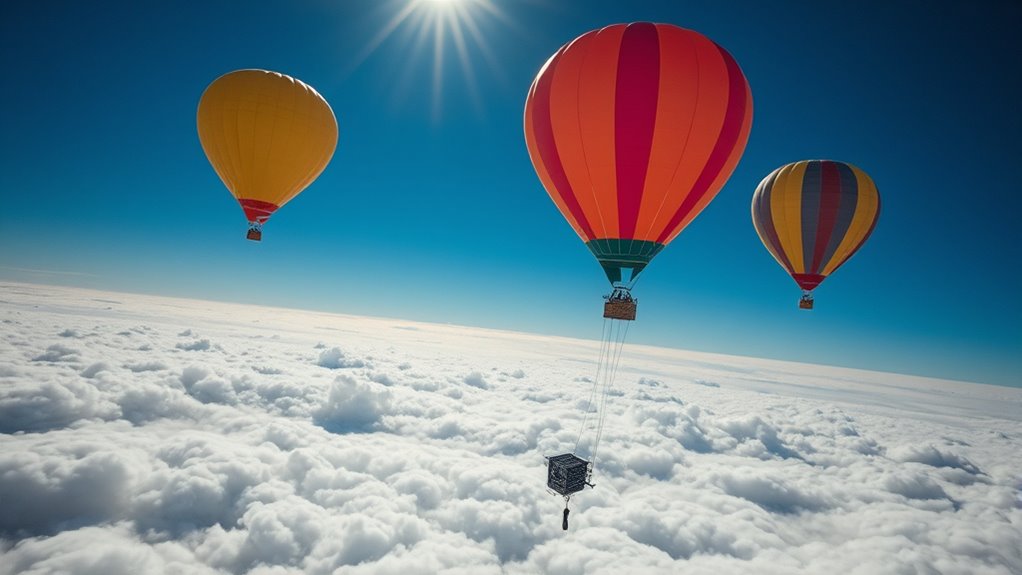High-altitude balloons are perfect for catching cosmic rays above the clouds because they operate in the stratosphere, where Earth’s atmosphere is thinner. This altitude reduces interference and lets you detect high-energy particles more clearly before they are altered by atmospheric effects. By launching these balloons, you can observe cosmic rays directly in their natural environment. Keep exploring to uncover how these balloon missions open new windows into space phenomena and atmospheric science.
Key Takeaways
- High-altitude balloons ascend above clouds to access cleaner, less atmospheric interference for cosmic ray detection.
- They carry specialized instruments that record secondary particles produced when cosmic rays interact with the atmosphere.
- Operating above clouds provides clearer, more accurate measurements of cosmic ray flux and energy levels.
- Balloons enable cost-effective, rapid deployment for studying cosmic rays at near-space altitudes without space missions.
- Data collected helps scientists understand cosmic ray origins and atmospheric interactions with minimal atmospheric noise.
The Science Behind Cosmic Rays and Their Significance

Cosmic rays are high-energy particles that travel through space and constantly bombard Earth’s atmosphere. Their origins, known as cosmic ray origins, include sources like supernovae, black holes, and distant galaxies. When these energetic particles reach Earth, they collide with molecules in the atmosphere, creating a cascade of secondary particles through atmospheric interactions. These interactions produce showers of particles that reach the surface and can be detected with specialized instruments. Understanding cosmic rays helps scientists learn about their distant sources and the processes happening in the universe. Additionally, studying how cosmic rays interact with our atmosphere reveals insights into atmospheric chemistry and radiation levels. This knowledge is essential for space exploration, aviation safety, and understanding Earth’s natural radiation environment. As advancements in AI technology continue, researchers are exploring new ways to analyze cosmic ray data more efficiently and accurately.
How High-Altitude Balloons Are Used for Cosmic Ray Detection

You set up specialized instruments inside high-altitude balloons to detect cosmic rays as they pass through the atmosphere. These devices are carefully arranged to collect accurate data during the flight. By analyzing this information, scientists can better understand cosmic ray interactions at different altitudes. Implementing vertical storage solutions within the payload can optimize space for all necessary equipment.
Balloon Instrumentation Setup
High-altitude balloons are equipped with specialized instruments that enable scientists to detect cosmic rays effectively. To guarantee accurate measurements, you focus on several key aspects of the instrumentation setup:
- Maintaining altitude stability, so sensors stay within the ideal detection zone despite turbulence.
- Precise payload integration, ensuring all instruments are securely mounted and properly connected to prevent data loss.
- Using lightweight, durable materials that withstand extreme conditions while keeping the payload manageable for the balloon’s lift capacity.
This careful setup allows your instruments to operate reliably during the flight. Proper altitude stability minimizes signal interference, while effective payload integration ensures seamless data collection and system performance. Your meticulous planning ensures the success of the cosmic ray detection mission.
Data Collection Methods
With the instrumentation setup in place, the next step is to understand how data is collected during the balloon’s flight. Your balloon design plays a vital role in ensuring accurate cosmic ray detection, with sensors positioned to capture secondary particles effectively. As the balloon ascends, detectors record interactions caused by cosmic rays hitting the atmosphere. The data analysis techniques then process this raw information, filtering noise and identifying meaningful events. You’ll rely on real-time telemetry to monitor instrument performance and collect data continuously. Once the flight concludes, you analyze the stored data, using statistical methods to interpret cosmic ray flux and energy levels. This combination of precise balloon design and advanced data analysis techniques enables you to gather valuable insights about cosmic rays from high above the clouds.
Designing and Building Balloon-Based Cosmic Ray Instruments

Designing and building balloon-based cosmic ray instruments involves careful consideration of both scientific goals and engineering constraints. To guarantee success, you must focus on key elements:
- Balloon aerodynamics – optimize shape and materials to reduce drag and withstand high-altitude conditions.
- Payload stabilization – incorporate gyroscopes, fins, or damping systems to keep instruments steady amid turbulence.
- Component integration – select lightweight sensors, power sources, and data loggers that work seamlessly without adding excess weight.
Advantages of Stratospheric Elevation for Cosmic Ray Observation

Rising to the stratosphere helps you reduce atmospheric interference, allowing clearer cosmic ray measurements. This elevation also boosts detection sensitivity, making it easier to observe faint signals. Plus, it broadens the observation spectrum, giving you access to a wider range of cosmic phenomena. Additionally, operating at high altitudes can contribute to biodiversity conservation, as it minimizes environmental impact compared to ground-based facilities.
Reduced Atmospheric Interference
At high altitudes, the thinner atmosphere considerably reduces interference from air particles and radiation, allowing cosmic rays to reach detectors more clearly. This reduction improves measurement accuracy and data quality. To achieve reliable results, you need precise altitude calibration and accurate atmospheric modeling, which account for changing conditions. The benefits include:
- Minimizing background noise from atmospheric particles, enhancing signal clarity.
- Simplifying atmospheric modeling, leading to more accurate correction factors.
- Improving the detection of rare high-energy cosmic rays, since less atmospheric interference means fewer data distortions.
- Utilizing robust equipment designed specifically for high-altitude conditions to ensure data integrity.
These factors enable your instruments to capture cosmic rays with greater precision, making high-altitude balloons a powerful tool for cosmic ray research. Reduced atmospheric interference directly translates into cleaner, more reliable data collection.
Enhanced Detection Sensitivity
By operating at stratospheric altitudes, your instruments can take advantage of increased detection sensitivity for cosmic rays. At higher balloon altitude, you encounter less atmospheric interference, allowing your detectors to better observe the true cosmic ray flux. This elevation reduces the scattering and absorption of particles, making your measurements more accurate and reliable. As a result, you can detect even the faintest cosmic ray signals that might be missed at lower altitudes. The thinner atmosphere at these heights minimizes background noise, enhancing your ability to analyze the energy and composition of incoming particles. Overall, the elevated position markedly boosts the sensitivity of your cosmic ray observations, providing clearer, more detailed data about these high-energy phenomena. Additionally, operating at these heights enables you to study cosmic ray origins more effectively by observing particles with minimal atmospheric distortion.
Broader Observation Spectrum
Have you ever considered how stratospheric altitudes expand your observational capabilities? At these heights, you access a broader range of cosmic rays, as atmospheric dynamics become less influential. This means you can observe particles unaffected by lower-altitude interference. Specifically, stratospheric balloons enable you to:
- Detect higher-energy cosmic rays that are absorbed or scattered at lower levels
- Minimize cosmic ray modulation caused by Earth’s magnetic field and atmosphere
- Obtain clearer data on cosmic ray interactions, improving understanding of their origins
- Balancing career and personal life is crucial for maintaining consistent observation schedules and ensuring safety during high-altitude missions.
This elevated perspective allows for more accurate measurements, revealing subtle variations in cosmic ray flux. By operating above much of Earth’s atmosphere, you enhance your ability to study cosmic phenomena and better understand atmospheric effects on cosmic ray behavior.
Notable Missions and Experiments Using Balloons

Throughout recent history, high-altitude balloons have enabled groundbreaking missions and experiments that expand our understanding of the Earth’s atmosphere and beyond. Notable missions include NASA’s Balloon Program, which has launched payloads to study cosmic rays, solar radiation, and atmospheric composition. During these missions, balloon inflation is carefully managed to guarantee stability and safety, with ground support teams monitoring weather conditions, controlling altitude, and coordinating recovery efforts. The use of sophisticated instrumentation allows scientists to collect valuable data from near-space environments. These experiments have led to discoveries about high-energy particles, atmospheric layers, and even cosmic phenomena. Thanks to these successful missions, high-altitude balloons continue to be essential tools for scientific research, advancing knowledge without the need for costly space launches. Proper test case management ensures the reliability and accuracy of experimental data collected during these missions.
Challenges in Conducting Balloon-Based Cosmic Ray Research

Conducting balloon-based cosmic ray research presents several significant challenges that researchers must carefully navigate. Weather unpredictability can abruptly halt launches or damage equipment, making planning difficult. Unfavorable conditions like storms or high winds can compromise data quality and safety. Additionally, regulatory hurdles add complexity to balloon missions. You need to secure permits from aviation authorities, which can involve lengthy approval processes and strict safety protocols. The regulations may vary by region, requiring thorough understanding and compliance. To succeed, you must:
- Monitor weather forecasts closely and plan launches during stable conditions.
- Prepare contingency plans for weather-related disruptions.
- Engage with regulatory agencies early to ensure all requirements are met.
- Ensure safe operation by adhering to safety standards and proper procedures.
Overcoming these challenges demands meticulous planning, flexibility, and adherence to safety standards.
Insights Gained From Balloon Observations of Cosmic Particles

Balloon observations have considerably advanced our understanding of cosmic particles by providing direct, high-altitude measurements that are otherwise difficult to obtain. These flights reveal how cosmic rays interact with Earth’s atmosphere, helping you refine models of particle origins and behavior. However, weather variability directly impacts your data collection, as sudden shifts can disrupt launches or affect instrument accuracy. Managing balloon launch logistics becomes essential to guarantee consistent results, especially when aiming for specific altitudes or timing. By analyzing the particles collected, you gain insights into the energy levels, composition, and flux of cosmic rays above clouds. Incorporating tuning techniques can optimize instrument performance and data accuracy during balloon missions. This information enhances your overall knowledge of cosmic phenomena and contributes to better predictive models, despite the challenges posed by weather and logistical constraints.
Future Developments and Potential of Balloon-Borne Cosmic Ray Studies

Advances in balloon technology and instrumentation are opening new horizons for cosmic ray research, enabling more precise and higher-altitude measurements than ever before. These innovations pave the way for breakthroughs like exploring quantum entanglement effects in cosmic particles and improving atmospheric modeling accuracy. Your future efforts could include:
- Developing detectors that analyze quantum entanglement in cosmic rays, revealing fundamental particle behaviors.
- Integrating sophisticated atmospheric models to interpret cosmic ray data more accurately.
- Using high-altitude balloons to test new sensors and materials for increased durability and sensitivity.
- Incorporating automation technologies to streamline data collection and processing during balloon missions.
These developments will enhance our understanding of cosmic phenomena, bridge gaps between quantum physics and astrophysics, and refine atmospheric predictions, making balloon-borne studies more impactful than ever.
Frequently Asked Questions
How Do Balloon Instruments Differentiate Cosmic Rays From Background Radiation?
You differentiate cosmic rays from background radiation by calibrating your detector carefully and using data analysis techniques. Calibration guarantees your instruments accurately identify cosmic ray signals, reducing noise. Then, you analyze the data to filter out background radiation based on energy levels, direction, and timing. This process helps you isolate cosmic rays from other sources, ensuring your measurements are precise and reliable during high-altitude balloon experiments.
What Are the Safety Protocols for High-Altitude Balloon Missions?
Your safety during high-altitude balloon missions is as vital as the mission itself. You follow strict safety procedures, including pre-flight checks, weather assessments, and emergency plans. The balloon material must be durable and tested to withstand extreme conditions. Always wear protective gear and guarantee communication systems are operational. These protocols protect you from hazards like sudden weather changes and equipment failure, making your mission successful and safe.
How Long Can a Balloon-Based Cosmic Ray Experiment Typically Last?
Your balloon-based cosmic ray experiment can last from several hours up to a few days, depending on balloon altitude and fuel capacity. As the balloon ascends to higher altitudes, it encounters increased cosmic ray flux, which your instruments detect. The duration depends on factors like balloon material, weather conditions, and the payload’s weight. Planning carefully guarantees you maximize data collection during the most suitable altitude window.
What Are the Costs Associated With Launching Balloon-Based Cosmic Ray Detectors?
Think of launching a balloon-based cosmic ray detector as budgeting for a road trip—you need to pack light and plan wisely. Costs include equipment, balloon, and launch services, which vary with payload weight. If your budget constraints are tight, you might need to reduce payload weight or select more affordable materials. Overall, expenses depend on your experiment’s size, complexity, and the resources you can allocate, making careful planning essential.
How Do Balloons Withstand Extreme Temperature and Pressure Conditions at High Altitude?
You might wonder how balloons withstand extreme temperature and pressure at high altitudes. They use special material insulation to protect internal components from cold temperatures and pressure regulation systems to handle the low-pressure environment. These measures guarantee the instruments stay functional despite the harsh conditions, allowing the balloon to operate effectively while capturing cosmic rays above the clouds. Proper design and insulation are key to surviving those extreme conditions.
Conclusion
As you explore the heights where cosmic secrets whisper, balloon-based experiments offer a gentle glimpse into the universe’s mysteries. By rising above the clouds, you uncover new perspectives that ground-based eyes can’t see. With ongoing innovations, your journey into cosmic rays promises to reveal more wonders, guiding you toward a deeper understanding of the cosmos’ subtle dance. Embrace this soaring adventure—where every elevation brings you closer to the universe’s hidden stories.










